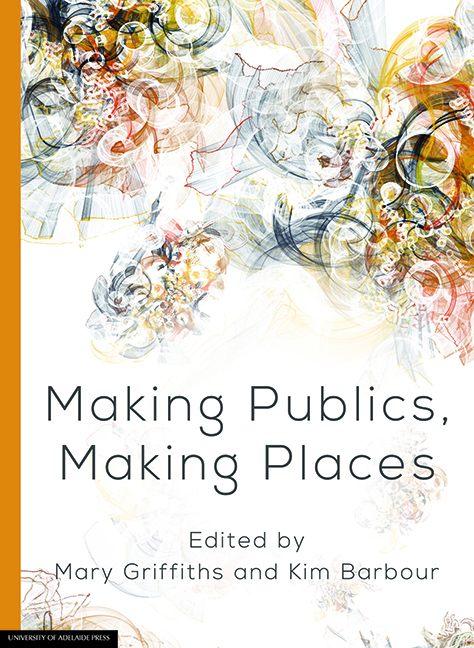Book contents
- Frontmatter
- Contents
- Preface
- Abstracts
- List of contributors
- 1 Making publics, making places
- 2 The elasticity of the public sphere: Expansion, contraction and ‘other’ media
- 3 ‘Imagine if our cities talked to us’: Questions about the making of ‘responsive’ places and urban publics
- 4 Picturing placelessness: Online graphic narratives and Australia's refugee detention centres
- 5 Reclaiming heritage for UNESCO: Discursive practices and community building in northern Italy
- 6 Find your Adelaide: Digital placemaking with Adelaide City Explorer
- 7 Chinese films and the sense of place: Beijing as ‘Thirdspace’ from In the Heat of the Sun to Mr Six
- 8 Social media and news media: Building new publics or fragmenting audiences?
- 9 The use of Chinese social media by foreign embassies: How ‘generative technologies’ are offering opportunities for modern diplomacy
- 10 An opinion leader and the making of a city on China's Sina Weibo
- 11 Public audiencing: Using Twitter to study audience engagement with characters and actors
- 12 Overcoming the tyranny of distance? High speed broadband and the significance of place
2 - The elasticity of the public sphere: Expansion, contraction and ‘other’ media
Published online by Cambridge University Press: 28 July 2017
- Frontmatter
- Contents
- Preface
- Abstracts
- List of contributors
- 1 Making publics, making places
- 2 The elasticity of the public sphere: Expansion, contraction and ‘other’ media
- 3 ‘Imagine if our cities talked to us’: Questions about the making of ‘responsive’ places and urban publics
- 4 Picturing placelessness: Online graphic narratives and Australia's refugee detention centres
- 5 Reclaiming heritage for UNESCO: Discursive practices and community building in northern Italy
- 6 Find your Adelaide: Digital placemaking with Adelaide City Explorer
- 7 Chinese films and the sense of place: Beijing as ‘Thirdspace’ from In the Heat of the Sun to Mr Six
- 8 Social media and news media: Building new publics or fragmenting audiences?
- 9 The use of Chinese social media by foreign embassies: How ‘generative technologies’ are offering opportunities for modern diplomacy
- 10 An opinion leader and the making of a city on China's Sina Weibo
- 11 Public audiencing: Using Twitter to study audience engagement with characters and actors
- 12 Overcoming the tyranny of distance? High speed broadband and the significance of place
Summary
Introduction
This chapter traces the shifting conceptual contours and parameters of the public sphere as they relate to ethnic minority, transnational and diasporic media. Each of these forms of media challenges the equation of public with nation, and nation with state, and problematises the housing of effective public policy within a bordered nation-state. Drawing on historical, political and theoretical critiques of the bourgeois public sphere ideal, several authors have taken minority media as being central to an understanding of multiple publics competing for political legitimacy and influence in increasingly diverse societies (Fraser 1990; Eley 1990; Calhoun 1992). Transnational media have been implicated in a similar process, wherein the location of the public sphere has been stretched to incorporate transnational public spheres, and even a global public sphere. Here, transnational and diasporic media are thought to be the engines upon which the expression of transnational publicness can occur. In many ways, then, this chapter engages with the question: ‘What media provide what kind of public spheres?’ (Butsch 2007, p. 3).
The public sphere as a critical theoretical model has undergone many changes since Habermas's original conception. Debates have raged over the idea's historical validity, its ability to incorporate differing sectors of complex modern societies into its discursive space, and its ability to capture globalising tendencies through which national borders are seemingly becoming more porous. What tends to remain central to discussions of the public sphere, however, is the centrality of questions over the communicative landscapes and structures within which deliberative debate can be said to take place. This chapter focuses on two developments in understandings of the public sphere, and the communicative landscapes so central to rational debate. The first concerns the fragmentation of the public sphere into smaller sphericules or spheres, coalescing with ideas of subnational publics and identity politics (Fraser 1990; Gitlin 1998; Cunningham 2001). The second concerns what Fraser calls the transnationalisation of the public sphere — that is, the way that, through increasingly prominent movements of people, goods and media across borders, the ideas of society, nation and community have been wrenched clear of their nation-state home (Cammaerts & van Audenhove 2005; Fraser 2014).
- Type
- Chapter
- Information
- Making Publics, Making Places , pp. 9 - 26Publisher: The University of Adelaide PressPrint publication year: 2016



